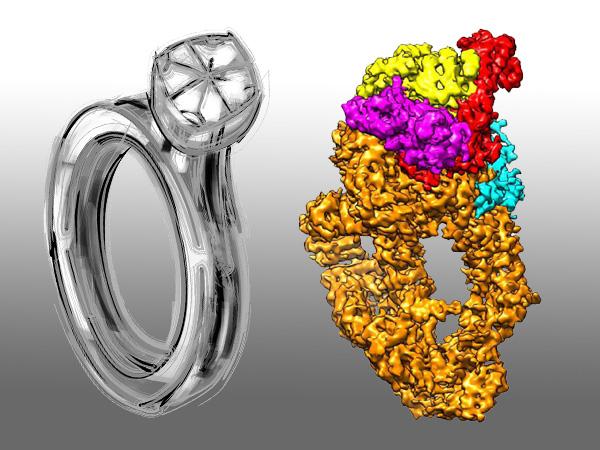USTC reports diamond ring architecture of a protein complex

The NuA4 cryo-EM structure is akin to a diamond ring. Credit: USTC News Center
NuA4/Tip60 is a complex which catalyzes diverse substrates critical for gene regulation, DNA repair, and cell cycle progression. Yet its compositional complexity and conformational flexibility have long impeded researchers from exploring at high precision.
By utilizing cryo-electron microscopy (cryo-EM), CAI Gang's team provides a high-resolution view of this complex in sub-nanometer scale, and discloses how NuA4/Tip60 assemblies for the first time.
The 4.7 Å resolution structure illuminates Tra1/TRRAP and Eaf1 serve as a scaffold for NuA4/TIP60 assembly. Although Tra1/TRRAP lacks of kinase catalytic activity, it adopts active conformation of the catalytic domain in NuA4/TIP60 assembly.
Besides providing more insights about scaffolding and regulatory mechanisms of Tra1/TRRAP, the structure elucidates more details about NuA4/TIP60 subunits.
Unexpectedly, the structure also shows human TRRAP mutations are largely centered on the Tra1/TRRAP interaction surfaces mediating NuA4/TIP60 assembly. Since Tra1/TRRAP contains hotspots for tumorous generation, this observation warrants preventing cancer by targeting the scaffolding function of TRRAP.
In addition, since Tip60 is significantly down-regulated in many cancers (i.e. breast and prostate), specific inhibitors of Tip60 will promise major breakthrough in cancer treatment.
Talking about future plans, CAI Gang will focus on obtaining structure of the holoenzyme and determining the substrate specificity and catalytic mechanism of NuA4/Tip60. These could greatly facilitate the development of specific TIP60 inhibitors and potent chemotherapeutic drugs, aiming at treating more people suffering from cancer.
Media Contact
All latest news from the category: Life Sciences and Chemistry
Articles and reports from the Life Sciences and chemistry area deal with applied and basic research into modern biology, chemistry and human medicine.
Valuable information can be found on a range of life sciences fields including bacteriology, biochemistry, bionics, bioinformatics, biophysics, biotechnology, genetics, geobotany, human biology, marine biology, microbiology, molecular biology, cellular biology, zoology, bioinorganic chemistry, microchemistry and environmental chemistry.
Newest articles

NASA: Mystery of life’s handedness deepens
The mystery of why life uses molecules with specific orientations has deepened with a NASA-funded discovery that RNA — a key molecule thought to have potentially held the instructions for…

What are the effects of historic lithium mining on water quality?
Study reveals low levels of common contaminants but high levels of other elements in waters associated with an abandoned lithium mine. Lithium ore and mining waste from a historic lithium…

Quantum-inspired design boosts efficiency of heat-to-electricity conversion
Rice engineers take unconventional route to improving thermophotovoltaic systems. Researchers at Rice University have found a new way to improve a key element of thermophotovoltaic (TPV) systems, which convert heat…



